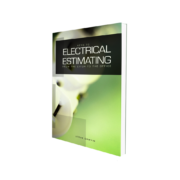The truth about Electrical Estimating Software
The truth about Electrical Estimating Software and On-Screen Takeoff Solutions is that they can win you more bids and make you more money because, you simply make less math mistakes, they allow you to bid more work in much less time, they streamline the process so after you dial in the software to your company’s needs you create uniform estimates every time.
When using the right electrical estimating software you can just enter a quantity and create long list of predetermined material. With old school pen and paper estimating if you had 100 120V Receptacles you would perform a similar task.
You would write out the following:
100-Receptacles
100-Boxes with bracket
100-Plaster Rings
100-Plates
100- Box
100-Blank plate
100-Ground Stingers
300-Wire nuts.
2000’-1/2 EMT
200-Couplings
200-Straps
200-Connectors
6000’ 12 THHN
Next you would enter a cost by each of the items above. Then you would insert your Man-Hours by each of the items. You are still not through. Now you need to extend the two list.
Keep in mind that this is just for 100 Receptacles.
So you do your own test. You enter these items, get a cost, extend the man-hours, and add tax, profit, and overhead to arrive at a cost.
With the right electrical estimating software this process will take less than 10 seconds.
So you can quickly see that computer estimating can save you time and make you money.
There are more choices of Electrical Estimating Software on the market than ever before. Many of these products are very good and as with everything some are a waste of time. So understanding that not every electrical program is the same let me shed some light on the subject.
Let’s start by identifying some of the differences between electrical bidding packages.
Some electrical software are nothing more than Shopping Carts where you open a database and select each item to bring into the estimate. There is little automation to these products.
These type of estimating software will help on extension mistakes but are very limited. This may be all you need but make sure of what you are purchasing.
A step up from the shopping cart style software are the group of electrical estimating programs that offer preset values to match your quantities. With these software you get the feel of automation along with the ability to grab items in a shopping cart fashion as well. These are often built on an Excel format and offer little or no variations such as changing the results or products. For example changing from EMT to MC or from 10’ to 20’. These types of electrical bidding programs offer little or no reports.
Top shelf product offerings are many steps above the Excel spread sheets. These offer all the bells and whistles that you might be thinking about when purchasing a software. After all every estimating software is made up of a database of products. These databases are reasonably the same with the same man-hours. So what are the differences in these products and why such a wide cost range?
The difference between the products is how user friendly you can get to the end result. I have used most electrical estimating products on the market and have been since they arrived on the market and I can pretty much get the same end result from all of them with time spent dialing them in to the way I estimate. Some of the older software on the market still embraces the Assembly Driven process. This is very much old school and having more choices does not make estimating easy. Having the right choices do. So imagine opening a software and having to wade through 30,000 Assemblies to find the one you need. Let me tell you from experience it will take several days to slowly read each of these and figure out what is included and which one you need. In time you will pick a few that you use and the rest will just stay in the way and never be used. The newer approach in more modern Electrical Estimating Software is what is referred to as Specification Driven in lieu of Assembly driven. The Specification driven products have default settings that you have pre-selected to match 90% of your work so all you do is enter quantities and the software does the work for you. Also everything can be changed on the fly or even after you have made the selection. So in reality your assemblies are unlimited and you can make them be what you want them to be at any time. This style of estimating is far superior and will be more accurate to your specific needs and save even more time.
Moving to the more robust offerings the first choice you need to make is do you need the ability to do On-Screen Takeoffs. This allows you to Importing your drawings into your software and doing your counts and measurements on your computer. This seems to be where most people’s interest is headed.
Something that you need to consider is many of the choices that offer this technology don’t actually have the ability to perform this task so they partner with other companies to offer this feature. After trying many of these I suggest that you mark these off the list. Having two different software can be problematic transferring date from the takeoff to the estimate.
Most are down right time wasters not time savers. For example I discovered while working with a couple of these software that you were forced to create a Tag in the estimating software then move to the on-screen takeoff software do your counts for that one tag only such as an A light fixture, then close and move back to the estimating software and enter the count. So you have to repeat this step for not only each tag but if you missed an A on the first try you must also enter your mistakes one at a time. Honestly I had rather print the plans and do the counts manually. Make sure you stay far away from having to work like this example.
A fact about electrical estimating software is you don’t always get what you pay for. The more you spend doesn’t always mean the better the software.
Sometimes the software you have heard about the most about is the most costly. This is due to an enormous advertising budget and large commissions paid out for sales people. Often times upper management is drawing enormous salaries.
When your overhead is out of control you must adjust your pricing by charging per seat or per license, charging for technical support, yearly updates, and many more hidden cost that are never mentioned. It can be a buyer beware. What happens if your computer crashes or you have a fire etc. You may be surprised to find you have to purchase the software again.
Find a company that has the heart of a teacher, Do your own research and don’t just follow the leader. Look for a company with knowledge in estimating not just sales people.
In closing below are a few tips that will ensure your success.
No matter how good any software is don’t purchase any electrical estimating software with the Intentions
Understand that all software will have a learning curve. You must commit to spending time watching the help files and working with the software weekly to master the process.
Follow the advice given by the company. Don’t try to reinvent the wheel.
Understand that this is a lifestyle change and the results and knowledge will pay dividends for your whole electrical career.
Turn off the TV and cell phone and set aside quite time without interruptions and learn the software. You will be glad you did.






